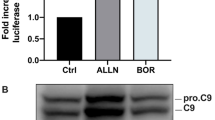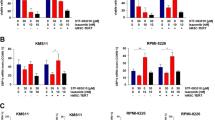Abstract
Targeting to the ubiquitin proteasome degradation pathway has become a promising approach for treating cancer. Previous studies showed that inhibition of the proteasome can induce apoptosis in various cancer cells. However, whether and how the inhibition of the proteasome induces other forms of cell death is not quite known. We previously showed that proteasome inhibitors including MG132 and Bortezomib could induce apoptosis in a Bax- and caspase-dependent way. In the present study, we found that in the absence of Bax and caspase activation, inhibition of the proteasome could also kill cancer cells by an alternative, non-apoptotic form of cell death. We further demonstrated that proteasome inhibitors, such as MG132, could induce intracellular accumulation of polyubiquitinated proteins and extensive cellular vacuolization likely due to ER stress. Translational or transcriptional inhibitors suppressed MG132-induced polyubiquitinated protein accumulation, and in turn inhibited MG132-induced ER stress, cellular vacuolization and cell death. These findings thus suggested that non-apoptotic cell death was resulted from misfolded protein accumulation and ER stress. Furthermore, our study indicated that proteasome inhibitors could be favorable chemotherapeutic agents because they could induce non-apoptotic cell death in addition to apoptosis, which could overcome resistance due to compromised apoptotic machinery.







Similar content being viewed by others
Reference
Hershko A, Ciechanover A (1998) The ubiquitin system. Annu Rev Biochem 67:425–479
Johnston JA, Ward CL, Kopito RR (1998) Aggresomes: a cellular response to misfolded proteins. J Cell Biol 143(7):1883–1898
Brodsky JL, McCracken AA (1999) ER protein quality control and proteasome-mediated protein degradation. Semin Cell Dev Biol 10(5):507–513
Schroder M, Kaufman RJ (2005) The Mammalian unfolded protein response. Annu Rev Biochem 74:739–789
Harding HP et al (2002) Transcriptional and translational control in the Mammalian unfolded protein response. Annu Rev Cell Dev Biol 18:575–599
Rao RV, Ellerby HM, Bredesen DE (2004) Coupling endoplasmic reticulum stress to the cell death program. Cell Death Differ 11(4):372–380
Breckenridge DG et al (2003) Regulation of apoptosis by endoplasmic reticulum pathways. Oncogene 22(53):8608–8618
Ding WX et al (2004) Bid-dependent generation of oxygen radicals promotes death receptor activation-induced apoptosis in murine hepatocytes. Hepatology 40(2):403–413
Coultas L, Strasser A (2003) The role of the Bcl-2 protein family in cancer. Semin Cancer Biol 13(2):115–123
Danial NN, Korsmeyer SJ (2004) Cell death: critical control points. Cell 116(2):205–219
Scorrano L, Korsmeyer SJ (2003) Mechanisms of cytochrome c release by proapoptotic BCL-2 family members. Biochem Biophys Res Commun 304(3):437–444
Mullauer L et al (2001) Mutations in apoptosis genes: a pathogenetic factor for human disease. Mutat Res 488(3):211–231
Galluzzi L et al (2007) Cell death modalities: classification and pathophysiological implications. Cell Death Differ 14(7):1237–1243
Klionsky DJ, Cuervo AM, Seglen PO (2007) Methods for monitoring autophagy from yeast to human. Autophagy 3(3):181–206
Bursch W (2001) The autophagosomal-lysosomal compartment in programmed cell death. Cell Death Differ 8(6):569–581
Leist M, Jaattela M (2001) Four deaths and a funeral: from caspases to alternative mechanisms. Nat Rev Mol Cell Biol 2(8):589–598
Edinger AL, Thompson CB (2004) Death by design: apoptosis, necrosis and autophagy. Curr Opin Cell Biol 16(6):663–669
Yu L et al (2004) Regulation of an ATG7-beclin 1 program of autophagic cell death by caspase-8. Science 304(5676):1500–1502
Shimizu S et al (2004) Role of Bcl-2 family proteins in a non-apoptotic programmed cell death dependent on autophagy genes. Nat Cell Biol 6(12):1221–1228
Pyo JO et al (2005) Essential roles of Atg5 and FADD in autophagic cell death: dissection of autophagic cell death into vacuole formation and cell death. J Biol Chem 280(21):20722–20729
Boya P et al (2005) Inhibition of macroautophagy triggers apoptosis. Mol Cell Biol 25(3):1025–1040
Lum JJ et al (2005) Growth factor regulation of autophagy and cell survival in the absence of apoptosis. Cell 120(2):237–248
Cusack JC Jr et al (2006) NPI-0052 enhances tumoricidal response to conventional cancer therapy in a colon cancer model. Clin Cancer Res 12(22):6758–6764
Zong WX, Thompson CB (2006) Necrotic death as a cell fate. Genes Dev 20(1):1–15
Zong WX et al (2004) Alkylating DNA damage stimulates a regulated form of necrotic cell death. Genes Dev 18(11):1272–1282
Li YZ et al (1999) Release of mitochondrial cytochrome C in both apoptosis and necrosis induced by beta-lapachone in human carcinoma cells. Mol Med 5(4):232–239
Salomon AR et al (2000) Understanding and exploiting the mechanistic basis for selectivity of polyketide inhibitors of F(0)F(1)-ATPase. Proc Natl Acad Sci U S A 97(26):14766–14771
Bai X et al (2003) Honokiol, a small molecular weight natural product, inhibits angiogenesis in vitro and tumor growth in vivo. J Biol Chem 278(37):35501–35507
Sperandio S, de Belle I, Bredesen DE (2000) An alternative, nonapoptotic form of programmed cell death. Proc Natl Acad Sci U S A 97(26):14376–14381
Castro-Obregon S et al (2002) A ligand-receptor pair that triggers a non-apoptotic form of programmed cell death. Cell Death Differ 9(8):807–817
Fribley A, Zeng Q, Wang CY (2004) Proteasome inhibitor PS-341 induces apoptosis through induction of endoplasmic reticulum stress-reactive oxygen species in head and neck squamous cell carcinoma cells. Mol Cell Biol 24(22):9695–9704
Chauhan D et al (2005) A novel orally active proteasome inhibitor induces apoptosis in multiple myeloma cells with mechanisms distinct from Bortezomib. Cancer Cell 8(5):407–419
Nawrocki ST et al (2005) Bortezomib sensitizes pancreatic cancer cells to endoplasmic reticulum stress-mediated apoptosis. Cancer Res 65(24):11658–11666
Ding WX et al (2007) A coordinated action of Bax, PUMA, and p53 promotes MG132-induced mitochondria activation and apoptosis in colon cancer cells. Mol Cancer Ther 6(3):1062–1069
Zhang L et al (2000) Role of BAX in the apoptotic response to anticancer agents. Science 290(5493):989–992
Zhao Y et al (2003) Bid activates multiple mitochondrial apoptotic mechanisms in primary hepatocytes after death receptor engagement. Gastroenterology 125(3):854–867
Ding WX et al (2007) Differential effects of endoplasmic reticulum stress-induced autophagy on cell survival. J Biol Chem 282(7):4702–4710
Yu J et al (2003) Differential apoptotic response to the proteasome inhibitor Bortezomib [VELCADE, PS-341] in Bax-deficient and p21-deficient colon cancer cells. Cancer Biol Ther 2(6):694–699
Vaux DL, Whitney D, Weissman IL (1996) Activation of physiological cell death mechanisms by a necrosis-causing agent. Microsc Res Tech 34(3):259–266
Nawrocki ST et al (2006) Aggresome disruption: a novel strategy to enhance bortezomib-induced apoptosis in pancreatic cancer cells. Cancer Res 66(7):3773–3781
Degterev A et al (2005) Chemical inhibitor of nonapoptotic cell death with therapeutic potential for ischemic brain injury. Nat Chem Biol 1(2):112–119
Kim JS, Qian T, Lemasters JJ (2003) Mitochondrial permeability transition in the switch from necrotic to apoptotic cell death in ischemic rat hepatocytes. Gastroenterology 124(2):494–503
Richardson PG (2003) Bortezomib: a novel therapy approved for multiple myeloma. Clin Adv Hematol Oncol 1(10):596–600
Adams J (2004) The development of proteasome inhibitors as anticancer drugs. Cancer Cell 5(5):417–421
Dewson G et al (2003) Conformational change and mitochondrial translocation of Bax accompany proteasome inhibitor-induced apoptosis of chronic lymphocytic leukemic cells. Oncogene 22(17):2643–2654
Ding WX et al (2007) Linking of autophagy to Ubiquitin-Proteasome system is important for the regulation of endoplasmic reticulum stress and cell viability. Am J Pathol 171(2):513–524
Strauss SJ et al (2007) The proteasome inhibitor bortezomib acts independently of p53 and induces cell death via apoptosis and mitotic catastrophe in B-cell lymphoma cell lines. Cancer Res 67(6):2783–2790
Acknowledgements
We would like to thank Benjamin S Mantell and Nicholus Maurice for critical reading of the manuscript. The authors are indebted to Dr. Bert Vogelstein (Johns Hopkins University) for the HCT116 Bax-positive and Bax-negative cell lines. Wen-Xing Ding is an American Liver Foundation Scholar. Xiao-Ming Yin was in part supported by the NIH funds (CA083817, NS045252) &CA11145).
Author information
Authors and Affiliations
Corresponding authors
Rights and permissions
About this article
Cite this article
Ding, WX., Ni, HM. & Yin, XM. Absence of Bax switched MG132-induced apoptosis to non-apoptotic cell death that could be suppressed by transcriptional or translational inhibition. Apoptosis 12, 2233–2244 (2007). https://doi.org/10.1007/s10495-007-0142-0
Published:
Issue Date:
DOI: https://doi.org/10.1007/s10495-007-0142-0




